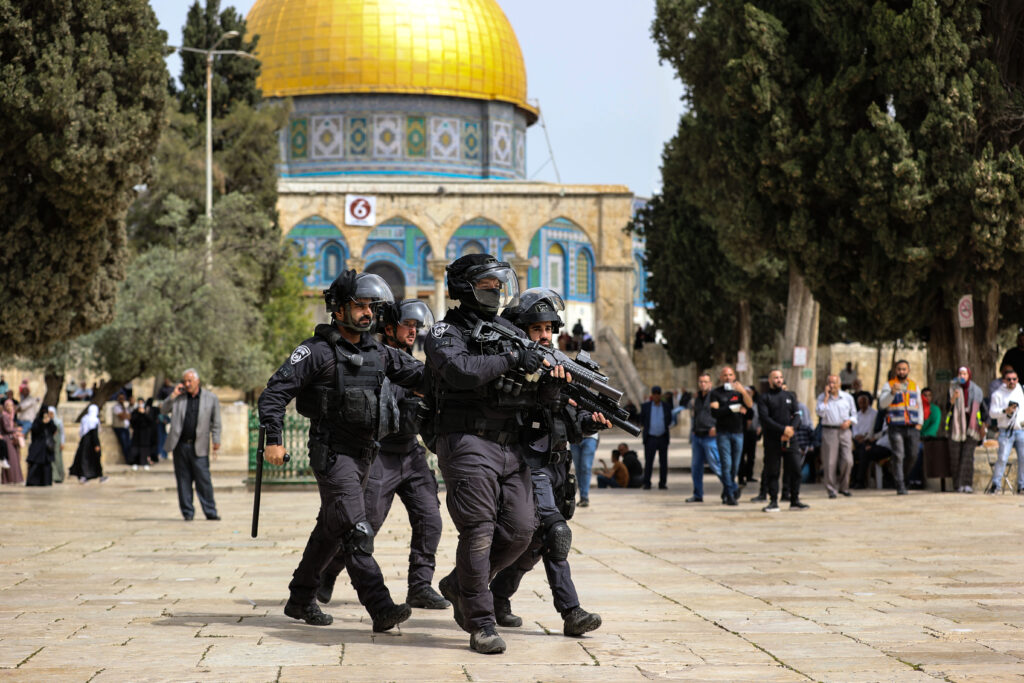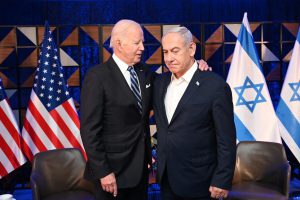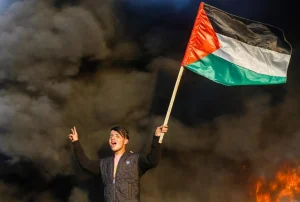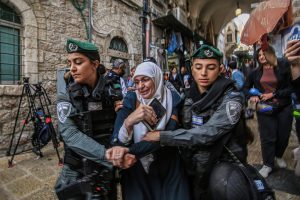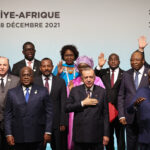The conventional wisdom in the Western world regarding the origins of the Gaza-Israel war is that the only necessary context is the Hamas-led attack on October 7, ignoring even the name associated with the offensive by Hamas: Al-Aqsa Flood. Although the conflict has even deeper roots, beginning over 100 years ago, the current Gaza war is also rooted in specific attacks during Ramadan for years.
As a basic principle embedded in Western mainstream discourse, from which all discussions are framed, Gaza and Israel are said to currently be at war over Hamas’ alleged “violation of a ceasefire” that is claimed was in place between Gaza and Israel until October 7. This approach necessitates the condemnation of the “initial” Palestinian offensive. However, this approach completely drowns out all context provided by the Palestinian side, taking only an Israeli perspective into consideration. It also robs the significance of Israel’s attacks on Palestinians during Ramadan from all discussions.
Al-Aqsa Flood: A Product of Attacks on Palestinians During Ramadan
Even the title for the operation that led to today’s war in Gaza, Al-Aqsa Flood, is missing across Western mainstream coverage of events, despite it being explicitly mentioned repeatedly across Arabic media and by every Palestinian group currently fighting the Israeli invading army in Gaza.
On top of the offensive having been an attack, that was, according to the Qassam Brigades’ (Hamas’ armed wing) spokesperson, Abu Obeida, launched with the purpose of inflicting a defeat on the Israeli military and capturing Israeli prisoners to exchange for what were some 5,000 Palestinian prisoners, it was also a response to what the group expressed were threats to the third holiest site in the Islamic faith; Al-Aqsa Mosque.
During Ramadan of 2021, Israeli occupation forces in and around the Old City of occupied Jerusalem imposed restrictions on both Muslim and Christian Palestinian worshippers. There were repeated attacks on Muslim worshippers inside the grounds of the Al-Aqsa Mosque compound, leading to hundreds of injuries. Videos emerged, which went viral on social media, featuring Israeli occupation police forces firing rubber-coated steel bullets into worshippers during the act of prayer. At that time, home demolitions in East Jerusalem and active attempts by armed illegal settlers to seize Palestinian homes in the neighborhood of Sheikh Jarrah also added to the tensions caused by the attacks on civilians in the Al-Aqsa Mosque compound.
In fact, if we are to take the cases of the five Ramadans prior to 2023, including the assaults on Palestinian worshippers inside occupied Jerusalem in 2018, 2019, and 2020, we see a clear trend of steadily escalating violence from the occupier year by year.
An area of almost daily confrontation throughout Ramadan has been the Bab al-Amoud (Damascus Gate) area, where Palestinian Muslims would routinely gather after breaking their fasts. In 2021, Israeli occupation police upped their presence in this area, located in what is known as the Arab Quarter of the Old City of Jerusalem, also escorting and protecting right-wing settler mobs who organized “death to Arabs” protests.
Around this time, what is known as the “Temple Mount Movement” settler groups upped their provocative actions and began campaigns to run incursions into the site, using groups of Israeli religious fanatics. These religious right-wing settlers, who received backing from the likes of the current National Security Minister, Itamar Ben-Gvir and the Israeli government, played a crucial role in escalating tensions throughout Jerusalem, some of whom had launched spontaneous attacks on Palestinians after hearing them speak Arabic.
On May 10, at the end of Ramadan, Israeli settler extremists had planned a provocative march that was coordinated to take place in the Old City and threatened to reach Al-Aqsa Mosque. This is when Hamas, which had refrained from any violence throughout Ramadan, issued a 6 PM deadline for the Israeli authorities to end all hostilities in occupied Jerusalem. Despite the clearly issued threat, Israeli occupying forces again stormed Al-Aqsa Mosque and attacked worshippers, while the city of Jerusalem erupted into uncontrolled riots between Israelis and Palestinians, resulting in over 400 injuries. As promised, the Qassam Brigades of Hamas opened fire with a barrage of rockets towards occupied West Jerusalem and declared the battle of Saif al-Quds (Sword of Jerusalem).
This escalation ended up resulting in an uprising amongst Palestinian citizens of Israel, who were motivated to protest and riot after watching the events unfold at Al-Aqsa Mosque and also due to uncontrolled gang violence in their communities, which they accused the Israeli police of aiding. What then ensued was a bombing campaign against the besieged Gaza Strip, along with an eruption of protests in the West Bank, East Jerusalem, and the rest of occupied Palestine. As a result, nearly 300 Palestinians were killed, thousands were injured, and over 74,000 were displaced. This escalation lasted for 11 days until a ceasefire was brokered with the armed groups in Gaza.
Following this battle sometimes referred to as the Unity Uprising, Hamas warned that further attacks on Al-Aqsa Mosque and Muslim worshippers would result in a wider war, one which the Secretary-General of Lebanon’s Hezbollah, Seyyed Hassan Nasrallah, stated he was forming a regional coalition to join in protection of Jerusalem’s Holy Sites during Ramadan.
Another important development that emerged from the May 2021 war,was that Hamas had formed the “Joint Room,” which brought some 12 armed groups into Gaza under the direct command of its Qassam Brigades and allowed for complete coordination on all military developments. Simultaneously, armed resistance groups began to form inside the West Bank, first in the Jenin Refugee Camp under the banner of the Jenin Brigades, then in other cities and camps throughout the occupied territory. The formation of such groups represented a significant development in the territory, which was actively being eyed for de jure annexation by the Israelis and hadn’t witnessed the formation of such armed groups since the early 2000s.
On December 14, 2022, the Islamic Resistance Movement (Hamas) organized a mass rally in the Gaza Strip, during which the Hamas leader in Gaza, Yahya Sinwar, openly used the language of a “flood” that was coming in revenge for repeated attacks on worshippers at Al-Aqsa Mosque that same year. Sinwar passionately warned that “we will come to you with an endless number of rockets, we will come to you with an endless number of soldiers,” as a threat to Israeli Prime Minister Benjamin Netanyahu, who had just formed his ultra-right-wing coalition. The Hamas leader also accused Israel of attempting to start a “religious war” and said that Al-Aqsa Mosque was under threat by the “Talmudic, fascist, Zionist, rightist government.”
In August of 2022 and then May of 2023, the Israeli military carried out two separate unprovoked attacks against the Gaza Strip, killing a majority of civilians each time, in clear violation of the ceasefire reached in May of 2021. Additionally, Itamar Ben-Gvir, who by late 2022 had been appointed National Security Ministerin Netanyahu’s new government, made his first move in power to storm Al-Aqsa Mosque and provoke an urgent United Nations Security Council meeting. In May, he stormed the Holy Site again and declared, “We are in charge here,” in clear violation of the internationally accepted status quo, which grants the Hashemite Kingdom of Jordan custodianship over the site. Ben-Gvir also challenged Hamas when inside Al-Aqsa Mosque, stating that “all of the threats from Hamas don’t matter. We are in charge in Jerusalem and in all of the Land of Israel”.
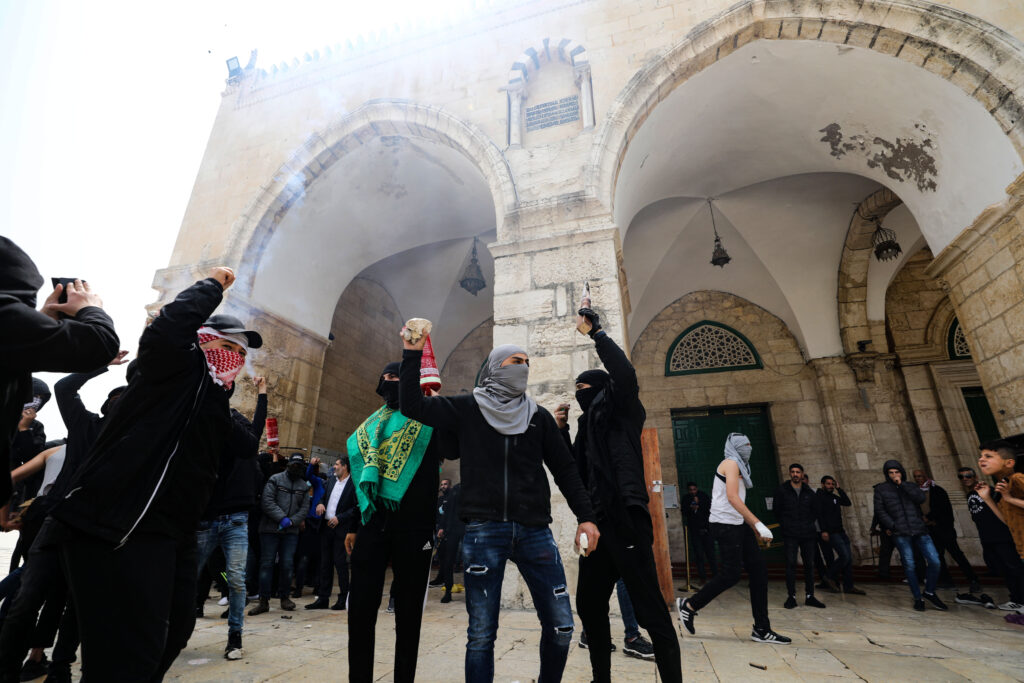
The repeated assaults on Palestinian worshippers in occupied Jerusalem during Ramadan of 2021, 2022, and 2023, combined with the repeated threats from Israeli ministersand escalating aggressionfrom the regime backed illegal settler movements, necessitated action in the minds of the Palestinian resistance movements.
Historically, ranging back as far as 1929 during the British Mandate of Palestine, the Zionist Movement provoked violent uprisings from the Palestinian people as a result of open threats made to the status of Al-Aqsa Mosque. In fact, the 1929 Buraq uprising was triggered by Zionist rabbis who called Jewish immigrants to gather at Al-Aqsa’s Al-Buraq wall (known to Jews as the Wailing Wall) with the goal of seizing it and declaring it a sacred place for Jews. The Palestinian uprising involved an indiscriminate attack on Jewish residents of al-Khalil (Hebron), and compelled Palestinians in the city to hide much of the Jewish community from the riots. The provocation at Al-Aqsa was the spark that inspired the Palestinian workers to launch their first national insurrection against the British and Zionist movement.
To bring things to more recent times, in 2015, after Israeli occupying forces assaulted worshippers and stormed Al-Aqsa Mosque in September, massive clashes erupted in response. This led to what is known as the “Knife Intifada,” where individual Palestinians unleashed an unprecedented number of lone-wolf attacks on Israeli forces. What is often unmentioned, however, is that tensions also escalated from the first day of Ramadan in 2015, after Israeli settlers invaded Al-Aqsa Mosque along with the occupation forces and proceeded to provoke worshippers throughout the Holy Month that year.
The Temple Mount settler movement, which has the backing of the wider illegal settler movement, openly threatens to not only take over Al-Aqsa Mosque but to destroy it in order to build a synagogue in its place. Precedence for such action exists in the city of al-Khalil, where the Ibrahimi Mosque – considered the second holiest Mosque in Palestine – was divided and more than half taken over to be used as a synagogue. In order for Palestinians to use this Mosque, they are forced to go through a humiliating checkpoint, then held at gunpoint and questioned before they are allowed to enter the Mosque. This development occurred after a right-wing settler from New York, Baruch Goldstein, entered the Mosque and murdered 29 worshippers in 1994.
Ramadan is known to be a month of escalated tensions due to the actions of the occupation forces and the willingness of the Palestinian people to make greater physical sacrifices in the protection of their Holy Sites. With what the International Court of Justice has accepted to plausibly be a genocide occurring in Gaza, the people of occupied Jerusalem, the West Bank, along with the Palestinian citizens of Israel, are all the more likely to rise up during Ramadan, assuming Israeli forces again launch an assault on worshippers at Al-Aqsa Mosque.
It is clear that this is a possibility being taken into consideration by policymakers in Washington, who had called for a ceasefire during Ramadan, demonstrating that the US government directly connects the war in Gaza to Al-Aqsa Mosque and, more specifically, to Israeli attacks on Palestinians during Ramadan. This is because, despite their refusal to acknowledge this publicly, the US understands what Hamas and the other Palestinian resistance groups have been saying since October 7: This is a war for the future of Al-Aqsa and not a random outburst of violence that has no context. What we see today comes as a direct result of repeated attacks on Palestinians during the Holy Month of Ramadan, which have steadily escalated as the years go by.

